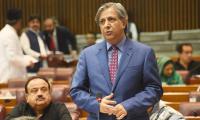ISLAMABAD: President Arif Alvi has reconstituted 10-member National Finance Commission (NFC) under Minister for Finance Asad Umar that will kick-start deliberations to evolve consensus among the Centre and provinces over resource distribution formula from the Federal Divisible Pool (FDP).
President has constituted the NFC under article 160(1) of the Constitution of the Islamic Republic of Pakistan. The NFC will be comprised of federal minister for finance and four finance ministers representing their provinces. The non-official members into the fold of NFC will be Dr Salman Shah, representing Punjab, Asad Sayeed from Sindh, Musharraf Rasool from KP and Mahfooz Ali Khan from Balochistan. Federal Secretary Finance will be part of the NFC as an official expert.
Now the stage is set when deliberation can kick-start for evolving consensus on new resource distribution formula among the stakeholders. The NFC requires consensus as decisions cannot be taken with majority.
The 8th NFC Award was constituted on July 21, 2010, but it did not make an award, nor did the 9th NFC, constituted on April 24, 2015. Because of a lack of consensus, the 7th NFC Award remains operative till a new award can be agreed upon and implemented.
In the budget for financial year 2018-19, the federal government had estimated that the provinces would receive Rs2.59 trillion from the federal revenue and straight transfers, reflecting a 11.8 percent increase over revised budgetary estimates of Rs2.23 trillion for the previous fiscal year. Out of the total revenue of the federal government, Punjab stands to get Rs1.28 trillion, Sindh would receive Rs648 billion, Khyber Pakhtunkhwa would gain Rs426.605 billion (including 1 percent to compensate for the war on terror), and Balochistan would be allocated Rs233 billion.
Under the 7th NFC Award, the provinces agreed that shares of the FDP would be calculated according to a formula under which population size determines 82 percent of the allocation.
Another 10.3 percent would be determined by the incidence of poverty and backwardness, 5 percent by revenue collection and generation, and 2.7 percent by inverse population density.
Hospital management responded that only one post of BS-19 was vacant which is to be filled through direct recruitment
PMLN does not have a mandate from the people for privatising the SOEs: says Rabbani
Administrative Service Ali Hussain Malik and made him OSD in the Establishment Division
Establishment Division had notified Rizvi’s appointment as IGP Islamabad on March 30, but the Punjab government...
A British citizen of Pakistani origin has lodged formal complaint against FIA officer, alleging torture during a...
Former COAS admitted the army extended full support to Imran Khan’s government







